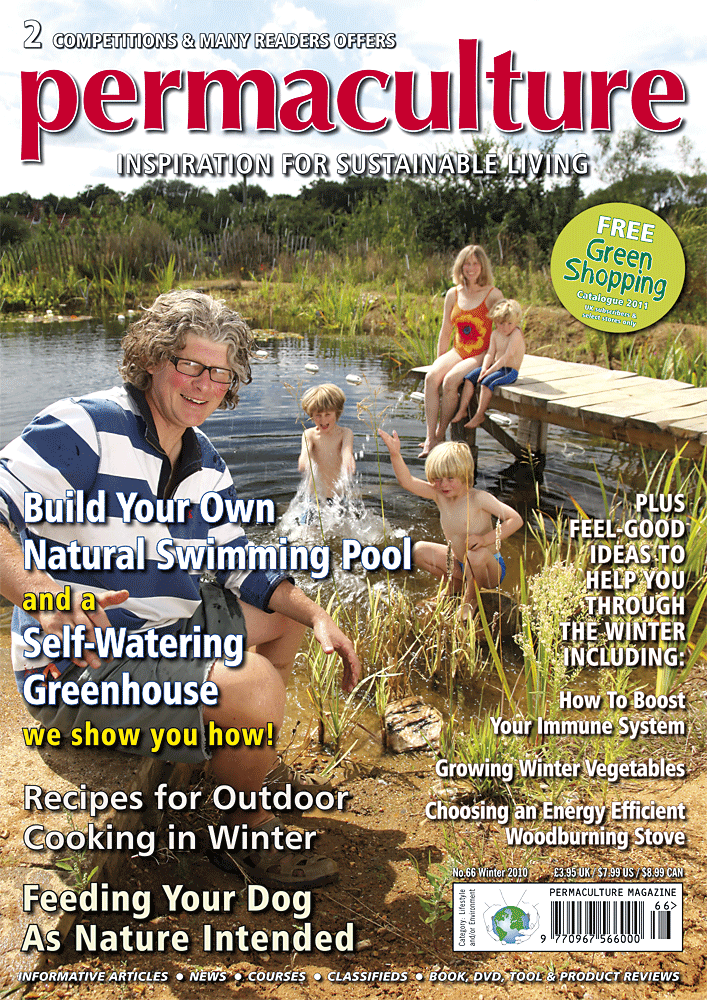|
|
|
|
|
PERMACULTURE MAGAZINE
Article 54
This is a sample article from a previous issues of Permaculture Magazine. Other recent articles are listed in articles
Older articles can be found in articles archive
All these articles are strictly copyright and must not be reproduced in any form without written permission. Please contact [email protected] if you have any queries.
|
Edible Gardening For The Senses
Ru Litherland describes how to integrate edible flowers into a productive garden.
Article first published in 'Permaculture Magazine' No. 54
|
|
|
|
“Have nothing in your house that you do not know to be useful or believe to be beautiful”1 was how East London’s favourite utopian socialist, William Morris, put it. The Arts and Crafts Movement he helped to found in the 19th century strived for a synthesis of the two, and presumably intended the same logic to be applied in the garden. Many traditional horticultural systems, such as the English cottage garden, represent fine unions between aesthetics and utility.
It was around the time ornamental gardening and food production went their separate ways, that things started to go badly wrong; in the garden, on the planet, in our communities, and in our heads. Permaculture, with one of its key principles being ‘every element should serve many functions’, offers one path beyond the beautiful/useful dichotomy, to a bountiful future where all horticultural activity is geared towards the optimisation of multiple yields.
Of course, there is nothing more beautiful than a well stewarded forest of moss curled parsley crisp with frost, or the swelling squash smiling at the sunset. But even I, a self-confessed vegetable nerd, can’t deny that there is nothing like colourful blooms to lift the spirits, and it is flowers that are universally acknowledged for their totemic and immediate beauty.
On Growing Communities’ urban market gardens in Hackney, East London, the challenge is to grow an attrac-tive space for volunteers and visitors, without compromising our key aim of growing significant amounts of produce for ‘zero food miles’ consumption in our neighbourhood. Over the last couple of years, we’ve been growing more vege-tables, more intensively than ever, but have also increased the volume of blossom on our sites. This has been done by prioritising flowers that can multitask!
Alongside visual beauty, then, we’ve favoured flowering plants that can tick plenty of other boxes, among them:
• Attracting beneficial insects to predate on garden ‘pests’. Happily any flowering plant boasts this function, though there are some that are particularly attractive to particularly beneficial insects.
• Attracting insects likely to aid pollination of fruit and ‘fruiting vegetables’.
• Deterring pests through strong scent.
• Suppressing weeds in the case of ground cover flora.
• Aiding soil improvement through nitrogen fixation or nitrogen ‘mopping’.
• Direct human uses such as medicine, tea, cut or dried flower, and seed, production
• And, of vital importance for us, being of good edible quality.
Many would regard the idea of flowers you can eat as a strange and novel one. But in fact, they already provide the world with some of its finest culinary delicacies: rose petal, primrose, gorse and elder-flower are the cream of the country wine makers’ crop; the latter, once frittered, are the sweetest treat on the temperate wild food menu. The stigma of the saffron crocus is the most highly prized spice of all. Globe artichoke flower buds have given us an unrivalled sensual eating experience, whilst those of broccoli are Britain’s favourite green; courgette flowers, stuffed or fried, are simply gourmet. Common floral garden volunteers such as nigella and poppy quickly develop widely used edible seeds; and of course there’s no fruit without blossom, but now we’re moving beyond our brief. The focus here is the production of petals for consumption raw in salads.
Niche Market Gardening
Growing Communities’ urban market gardens are three sites comprising 0.2 hectare (0.5 acre) in total, tiny by commercial standards, so the focus of our work is high value vegetables. For us, this means salad leaves. Our inner city situation means we are well placed to provide exceptionally fresh salad to members of our organic box scheme in the form of bowl-sized bags of mixed leaves. The beauty of this specialisation is that from a small space we can produce large amounts of one product without having to go down the road of monoculture, as each week we are harvesting between fifteen and forty diverse plants.
Edible flowers are harvested separately from the leaves, and a delicate bloom placed on the top of every packed salad bag immed-iately before sealing. So the flowers are technically a freebie, and the hallmark of a genuinely handmade product. They add colourful vibrancy to the leaves’ predominant greens and reds, and have a unique flavour of their own, as well as, presumably, a distinctive nutritional content (and effect – a notion developed by proponents of Bach Flower Remedies).
Where Do All The Flowers Go?
Here are four ways to incorporate them into the vegetable garden:
1. Permanent Beds
Perhaps the simplest way of ensuring the consistent presence of chosen flowers – edible or otherwise useful – is to ‘design in’ permanent beds or areas amongst, but separate from, the vegetable beds. This has the added advantage of providing a relatively stable vegetative ecosystem, benefiting all sorts of wildlife. For example, it will provide a refuge for frogs when other beds are being laid bare for spring planting.
At Growing Communities we have a permanent bed of mainly one plant – sage – which we can sell as a dried herb in the Christmas (stuffing) season. Alternatively, a polyculture may be preferred, an approach I encountered during my permaculture apprenticeship at Springfield Gardens in Bradford. The beds were described by the designer, Mark Fisher, as ‘IPM (integrated pest management) beds’ to technophile officials who tend to nod approvingly at scientific-sounding acronyms, but go under the moniker of ‘linear guilds’ when in permaculture circles, as detailed in his article, ‘Healthy Relationships In The Garden’ in PM33.
This system tends towards perennial or self-seeding plants and might include: the taller bergamot (Monarda didima), common bugloss (Anchusa officinalis) and evening primrose (Oenothera biennis); the bushier day lily (Hemerocallis spp.) and oregano (Origanum vulgare); and the shade tolerant ground cover of sweet woodruff (Asperula odorata) and sweet violet (Viola odorata).
2. Annual Strips
Growing perennials within annual beds tends towards an unsatisfactory clash of cultures: perennials tend to keep growing even after they’ve exceeded the space initially allocated to them – an irritating but ultimately under-standable habit. Conversely, routine soil disturbance and compost application commonly cause consternation amongst the plant community’s senior citizens.
On the other hand annual flowers are more or less compatible with annual veg, and one option is to grow the former as one course of the rotation. Few of the key edible flowers are members of the major vegetable groups, so this would be practical, but I’ve never seen it done. More common is to grow in smaller, posy-sized units targeted directly into the vegetable beds. We plant them in one or two rows of five or six plants, maximising the hunter-attracting power of nectar, and perhaps, just perhaps, proximity to pretty pansies lifts the spirits of our lettuce plants too.
3. Random Self-Assemblies
Self-seeders, like evening primrose and common mallow, Malvea sylvestris, can be allowed to decide for themselves where in the world to embark on their next life cycle. However, judicious weeding, roguing and thinning out is necessary if you wish to retain some control over the site’s planting plan and productivity, and select certain desired charac-teristics in the otherwise feral stock.
These random self-assemblies are a fine balance, and a fun sport, in a designed edible ground. In the spring it’s easy to forget that peppery jungles from cute nasturtium seedlings grow, but not all ‘volunteers’ take a mile: calendula can be trained to germinate on the edge of beds and footpaths, thus taking up the minimum of premium ground. It is of course possible to treat some vegetables, notably many salads, in the same way...
4. Vegetable Flowers
Many salad leaves are short season crops, and all can be cropped on a repeated basis (‘cut-and-come-again’) until their desire to run to flower makes the diminishing returns of leaf not worth the effort of harvesting. The good news is that directly after this point, you will be rewarded with a bonus yield of post-salad bouquets. These are particularly eye catching in the case of the brassicae (e.g. rocket, mizuna); and particularly useful bug magnets in the case of the umbelliferae (e.g. chervil, parsley) and compositae (e.g. lettuce, chicory). All are technically edible and therefore salad candidates, but trial and error is recommended on this front: parsley flowers are tough, bitter and neither colourful nor bold enough to really ‘lift’ a salad bowl; whilst chicory petals are a most stunning beyond-blue, but like so many things of indescribable beauty, fade once picked, so are no good for commercial salad bags.
Vegetable flowers are a very efficient method of flower production: there is no time and space given over to ‘coming on’ as there is a plentiful crop up to the point of blossoming. After this, the period of flower, and flower cropping, represents an extension of the plant’s useful life. At the urban market gardens one or two rows of useful and edible vegetable flowers are left in whilst the rest are pulled out as soon as possible to get the bed straight back into production.
This method allows scope for seed production for next season’s sowings. In the case of some, such as miner’s lettuce and corn salad, these can even be self-sowings. For important, highly cultivated salad crops like lettuce and rocket, it is worth consulting seed saving guidelines2 as with every generation one should be carefully selecting to ensure preferred characteristics and, in some instances (apparently paradoxically), for a broad gene pool.
Towards Profusion
The aim in this article is to make a logical case for including pretty flowers in even the most intensive of food production systems, if they aspire to be eco-logical/sustainable. My concentration has been on plant eye candy that you can eat; the assertion being that edible flowers are not a mere floral tribute to, but are the manifestation of, the ‘rainbow bridge that only connects’3 the dislocated worlds of un-productive ornamentals and colourless production.
Sound though I hope this case is, however, it is in part a rationalisation for a practice based as much on intuition as logic. The ‘bottom line’ is that at Growing Communities it would be more profitable to con-centrate on a few more lettuces instead of cultivating edible flowers. But it’s a bottom line that impoverishes us all: destructive alienating agro-industry has shown us what happens when the art and craft are taken out of food growing. For food is of fundamental, wonderful importance, and should absorb all our senses – sight, smell, touch and sound – not merely taste; and satisfy our souls as well as our bodies.
Or, as striking textile workers put it shortly after Morris’ passing, ‘give us bread, but give us roses’.4
Ru Litherland is the grower at Growing Communities and is involved with the Naturewise permaculture courses in London. He also makes elderflower wine and daisy chains.
A table of useful salading flowers accompanies this article click table to view.
1. For a good introduction to William Morris and the Arts & Crafts Movement, see William Morris: From Romantic to Revolutionary; EP Thompson; Merlin Press, 1997. Help the international campaign Save The William Morris Gallery in Walthamstow from council cuts!
www.keepourmuseumsopen.org.uk
2. Heritage Seed Library’s Seed Saving Guidelines, c/o Garden Organic: 024 7630 3517 www.gardenorganic.org.uk
Seed Savers Handbook; Cherfas & Fanton; Grover Books, 1993.
3. Howards End; EM Forster; Penguin Classics, 2000.
4. ‘Bread & Roses’, a poem by James Oppenheim that became a popular folk song, inspired by a banner made by women during the Lawrence Strike, USA, 1912.
The fully illustrated version of this article appears in PM54 and can be purchased as the current issue. |
|
|
|
|
|




 back issues
back issues


